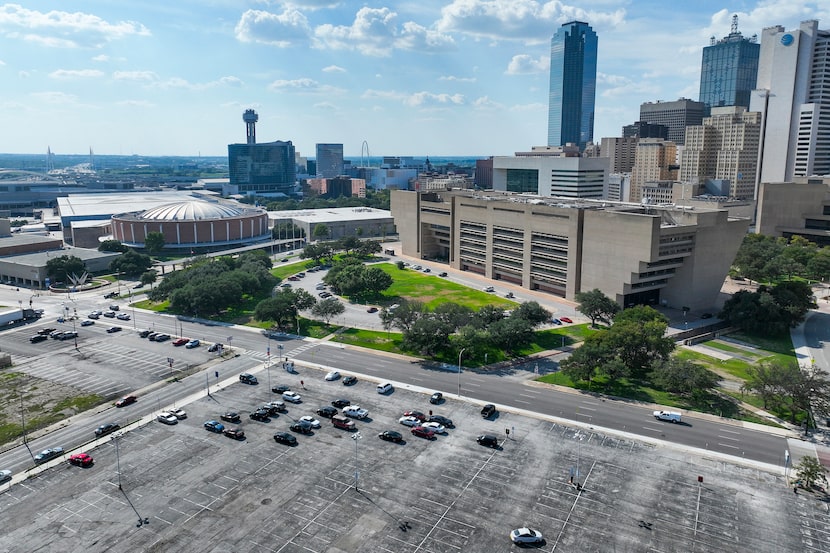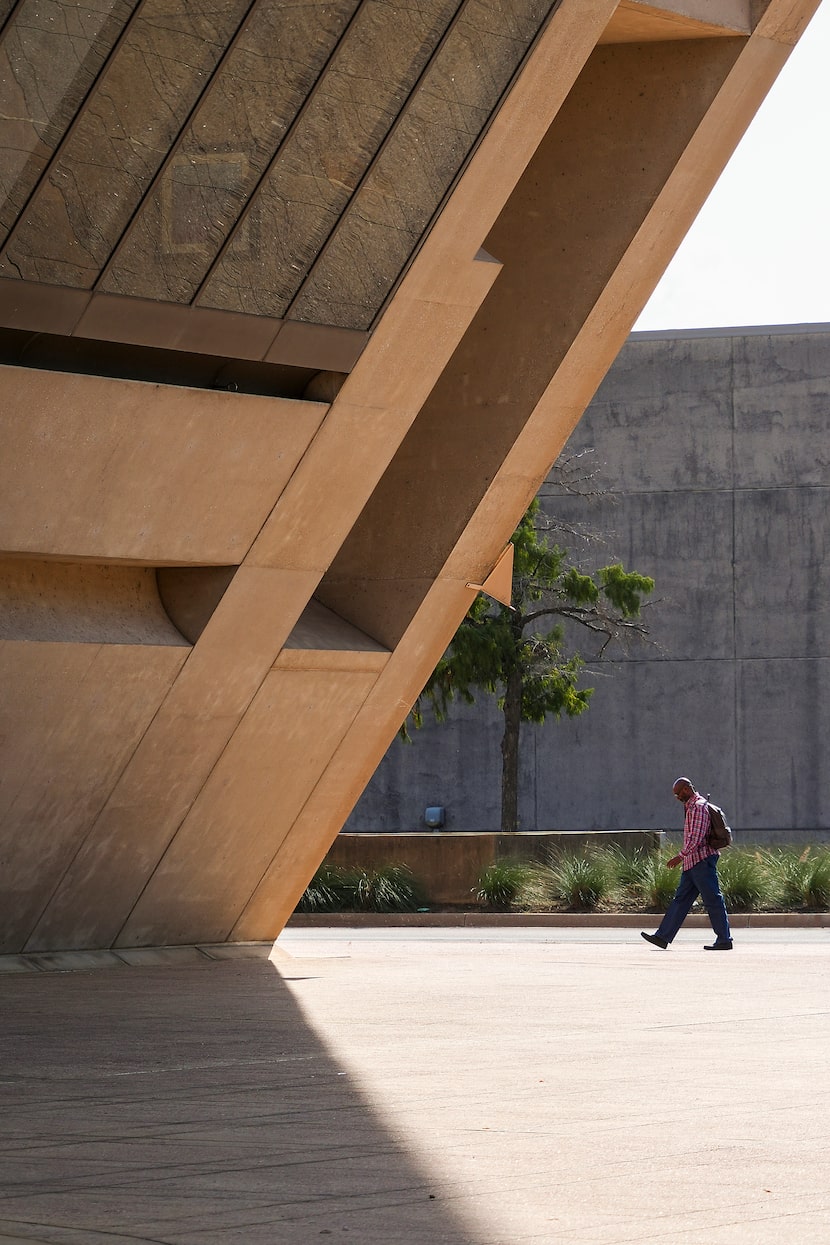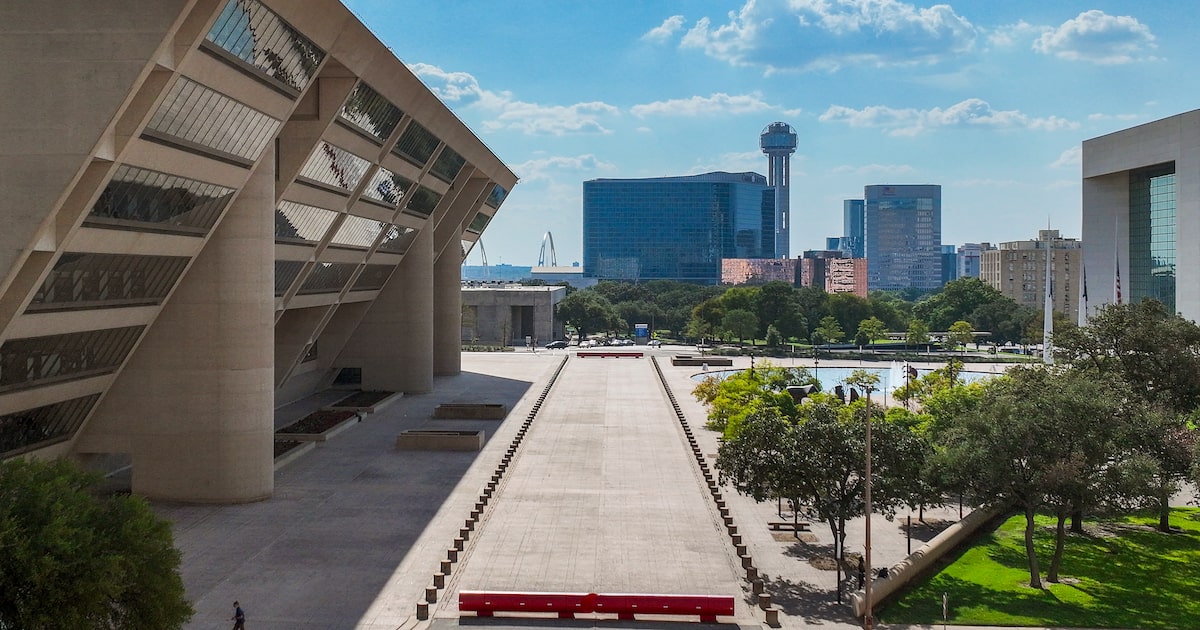Editor’s note: This story is part of a special report, “State of Play,” which examines the suitability of key North Texas locations most likely to be considered as a potential home for a new Dallas Mavericks arena complex.
As Dallas City Hall’s future hangs in the balance with mounting maintenance issues, the site in the southern half of downtown may have what’s needed for a new billion-dollar NBA arena for the Dallas Mavericks.
The building — an example of famed architect I.M. Pei’s Brutalist architecture with its imposing, geometrical body and exposed concrete — serves as the offices for the city’s top brass, City Council and several departments. Eagle-eyed sci-fi fans also remember the building as a filming location for the 1987 sci-fi flick RoboCop. Filmmakers used the building’s exterior to depict the headquarters of the antagonistic megacorporation that incubated the heroic cyborg in the movie.
Ray Washburne, who owns Founders Square, the old Dallas Morning News property and other downtown sites, said in August, while the City Hall building is a classic example of brutalist architecture, it is also “horrible” urban planning.
Political Points
“I wouldn’t tear it down just for the sake of tearing it down,” he said. “But, if you put in an arena with all the entertainment district, that will transform Dallas.”
The Mavericks’ current home, the American Airlines Arena, is an 850,000 square-foot facility with room to host 20,000 patrons. Compared to that, City Hall’s inverted pyramid, the park plaza in front of it, as well as the horseshoe-like parking lot in the back, gives the city enough room for an arena itself.
Located in a rather sleepy part of town, the project would require additional real estate around City Hall for an entertainment district. Some of it could come from the freed-up real estate near the soon-to-be revamped Kay Bailey Hutchison Convention Center, or from the available land across Interstate 30 near the Lorenzo Hotel and the Cedars.
Currently, the site, including its underground lot, has less than 2,000 parking spaces available. In comparison, the American Airlines Center has 5,000, with nearby parking garages built to accommodate the crowd’s needs.
The site’s zoning is specific to the central business district and allows for a wide variety of uses ranging from offices to multi-family housing, retail, art galleries and libraries.
The structure on 1500 Marilla St. was part of Dallas’ rebranding and self-introspection, an ambitious attempt to move away from the moniker of “city of hate” that grew stronger after President John F. Kennedy’s assassination on Elm Street.
The new City Hall opened to the public in 1978 and sits on an 11.8-acre site with the J. Erik Jonsson Central Library across the street. With a 1.5 million square-footage, the building has two levels of underground parking and is less than a quarter mile away from Interstate 30.
Two DART bus lines run parallel on Akard and Ervay streets around it. The closest light rail near City Hall would require pedestrians to cut through the new convention center. City Hall is also surrounded by hotels such as Aloft and Fairfield by Marriott Inn and Suites as well as the Omni hotel close by.
Downtown’s southern half is already on the cusp of dramatic redevelopment.
City officials are clearing acres by tearing down and remaking the Kay Bailey Hutchison Convention Center. Over 21 acres of land would be up for play. Memorial Auditorium, which will soon host WNBA’s Dallas Wings and is adjacent to 1500 Marilla St., will also get more than a facelift.

Aerial view of Dallas City Hall (right) and the Kay Bailey Hutchison Convention Center, along with surface parking lots that stretch between City Hall and IH30. are seen on Friday, Sept. 12, 2025, in Dallas
Smiley N. Pool / Staff Photographer
Developer Mike Hoque has plans to build apartments, a hotel tower and a business complex in the underutilized parking lots behind City Hall between Canton and Cadiz Streets. He received a $96 million incentive package from the city and purchased a city-owned building last year.
Last year, Hoque also purchased the city-owned building on 711 S. St Paul Street, which once held a homelessness services provider and was knocked down after being marred by neglect and vandalism. Hoque hasn’t yet begun construction and declined to comment on whether the city has approached him about his land in case there were to be a new arena.
Mavericks CEO Rick Welts told The News the Mavericks are looking for a 30- to 50-acre site in Dallas’ urban core. City officials have pitched two sites, and it’s unclear what those are. Next week, the council’s finance committee is scheduled to discuss the future of its real estate portfolio and City Hall is first in its order of business.
“I think we’ve said that downtown certainly has been one of the locations under discussion,” Welts said in a Sept. 17 interview. “We continue to take a look at that. But the city, I think whatever they’re doing with city hall, they’re doing for the city’s purposes. That’s as much as I know.”
Real estate experts who spoke with The News offered several potential arena locations, including near the Dallas convention center project, the former Valley View Center site and the current Dallas County jail property. The Lew Sterrett Justice Center near Commerce Street and Riverfront Boulevard is likely off the table.

A pedestrian passes Dallas City Hall with a portion of the Kay Bailey Hutchison Convention Center seen in the background on Friday, Sept. 12, 2025, in Dallas.
Smiley N. Pool / Staff Photographer
Meanwhile, city officials hired commercial real estate firm Hillwood Urban Services to research and suggest sites within city limits for a new arena and entertainment complex.
Tearing down City Hall or reshaping its real estate would mean the city would have to relocate its staff, and where they go is dependent on whether Dallas officials are looking to build a whole new campus or possibly utilizing the thousands of office spaces downtown.
“City Hall is dank, dark and demoralizing,” said Shawn Todd, a developer who owns multiple properties downtown and has repurposed two I.M. Pei buildings.
“My opinions regarding Dallas City Hall have nothing to do with the Dallas Mavericks,” he said. “It is a functionally obsolete building plagued with multiple issues that occupies land, which is strategically positioned for a dynamic mix of uses. It’s not a place to accomplish where Dallas needs to be on multiple fronts.”
“Not every architect’s work is remarkable. Not every building is redemptive let alone adaptive for reuse,” Todd said, adding that downtown and the City Hall needed bold and creative decisions.
A City Hall of the same size could cost taxpayers $200 million to $300 million in just construction, said Norm Alston, a planning and architecture expert who also serves in the city’s urban design peer review panel.
Perhaps the biggest opposition to using the City Hall site would come from preservationists who have decried the city’s habit of letting buildings deteriorate and tearing things down in the quest to build something new. Efforts to shield City Hall as a historic site are already underway in the Landmark Commission.
Landmark Commissioner Reagan Rothenberger initiated the process of designating City Hall as a historic site early this year.
The process typically takes six months or more and, if approved, any changes to the exterior of the building — whether it’s altering or repairing a facade or demolishing sections — would need city approval. The application is currently with the Landmark Commission’s designation committee, which is responsible for screening whether a property is eligible for protections.
The initiation process also puts the building under a moratorium.
Dallas officials cannot accept any permits to alter, demolish, or remove the structure or site until either the City Council, City Plan Commission or Landmark Commission votes to terminate the designation process, or if it’s been two years since the process was initiated, per city ordinance. Any changes to the building during this time would need applicants to file for a certificate of appropriateness. That, too, would need city approval.
Reporter Brad Townsend contributed to the story.

